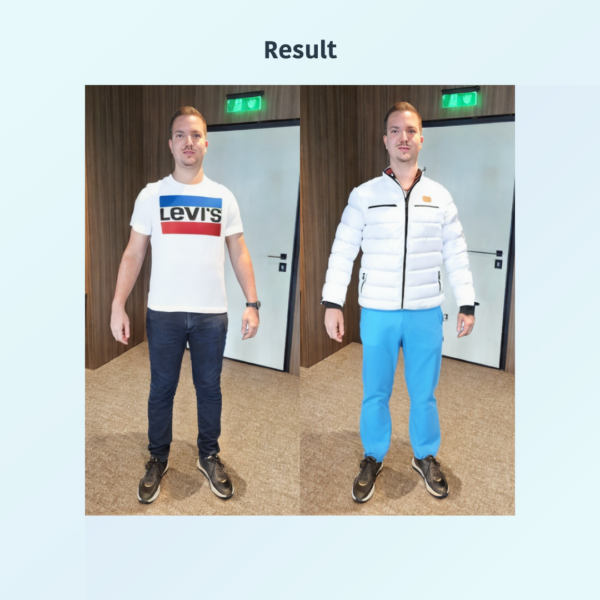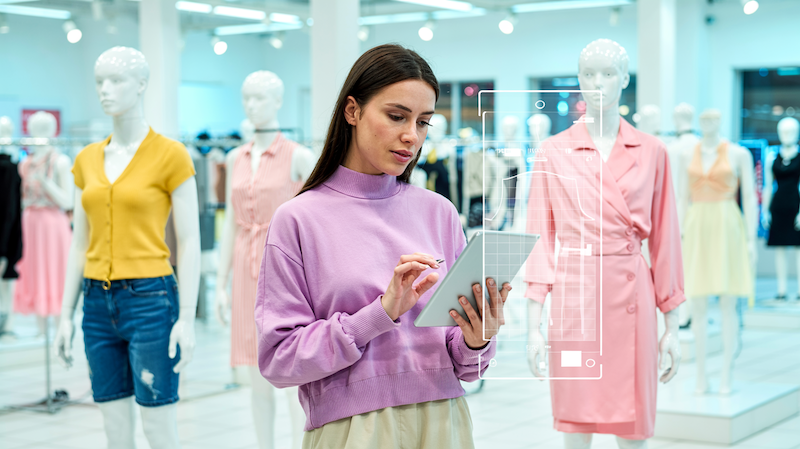Technology is stepping in to revolutionize most aspects of our lives, and the fashion industry is no stranger to this trend. Virtual try-on technology is revamping the way consumers choose clothes, accessories and makeup — and the whole shopping experience is being transformed.
The transformation of fashion e-commerce is a particularly important one, keeping in mind it’s one of the world’s biggest market segments. By 2029, the industry is expected to reach a market volume of $1.183 trillion, according to Statista.
The stunning growth is fueled by consumers’ massive use of mobile devices for shopping, as well as technological advancements — and virtual try-on technology is certainly among the leaders. As people become more and more tech-savvy, trying on clothes in a virtual dressing room and testing makeup on digital images is not an extra perk, but the expected norm.
Trying clothes virtually is enabled by the integration of Artificial Intelligence (AI), Augmented Reality (AR), and 3D scanning and modeling. Let’s dive into the details of how technology and fashion meet, the applications and benefits of virtual try-on technology, and the future ahead.
What is Virtual Try-On in Fashion?


Virtual try-on technology allows customers to interact with clothing and beauty products in a completely new way — changing the shopping experience and improving a number of aspects related to online purchases. People can try how clothes, accessories, makeup and other items suit them through a simulation, which is usually a virtual fitting room. The technology scans the face or body of the customer and visualizes how the product would look on them.
This preview helps people get a clear idea of how an item enhances their appearance. This way, they can make more informed purchasing decisions with a greater level of confidence.
Virtual try-on contributes to decreasing returns, improving overall customer satisfaction, and boosting product discovery — which helps increase sales and conversion rates. It contributes to the creation of personalized and highly immersive shopping experiences. Besides fashion, it has similarly useful applications for beauty, makeup, hairstyle and nail polish businesses, among others.
How It Works: The Technology Behind Virtual Try-On
Virtual try-on technology is fueled by a powerful blend of AR, AI, 3D scanning and mapping, and seamless e-commerce integration. The mix of these technologies allows for realistic and immersive ecommerce experience for customers.
Augmented Reality (AR)

Augmented reality has a central role in digital try-on. It allows the overlaying of items, such as virtual clothes, onto actual customer photos. The AR technology instantly maps their body or face in real time using the camera of their mobile device. Then it creates a digital representation which can be analyzed and modified.
Artificial Intelligence (AI)
AI algorithms are key for a couple of central virtual try-on functionalities, and in particular computer vision and image recognition. They enable size prediction for the customer, fit analysis of each item, and personalized recommendations for products. With the help of advanced image recognition algorithms, the try-on can thus suggest the best fit and style for a particular client.
3D Scanning and Modeling
Creating realistic representations of how an item fits a customer is powered by 3D scanning and modeling. The technology analyzes the measurements and shapes, allowing the generation of an avatar that is as close to the real person as possible. This makes the clothing preview accurate and reliable.
Integration with E-Commerce
The combination of these three technologies blends seamlessly together in the e-commerce platforms with the help of APIs and specialized software. This allows the smooth integration of try-on technology straight into e-commerce websites and apps — allowing the creation of virtual fitting rooms and similar simulations.
Benefits of Virtual Try-On for Consumers and Retailers
Virtual try-on can be used in a variety of sectors, including e-commerce platforms for clothes, accessories, beauty products, and makeup, as well as in-store experiences for traditional stores. It has applications in luxury fashion — and even in sustainability initiatives.
Virtual try-on technology brings a number of benefits and addresses key challenges in the retail industry. In particular, it improves customer experience, decreases operational inefficiencies, and drives a higher level of sustainability.
Enhanced Customer Experience & Lower Return Rates
Virtual try-on provides realistic previews of products that are interactive and immersive. It helps customers make informed purchasing decisions — decreasing returns and improving customer satisfaction with online shopping, as well as boosting convenience.
In-store Experience
Digital try-on technology has a role in physical retail spaces too. It offers virtual dressing rooms and personalized recommendations that help engage and retain customers who can discover new items through complimentary apps and platforms.
Challenges and Considerations
To maximize the potential of try-on in the retail industry, it’s important to know the potential challenges and considerations for its successful implementation.
Technical Limitations
There is a constant need for technological updating to manage issues with rendering accuracy, as well as compatibility across different devices, that may otherwise affect user experience.
Consumer Adoption
The learning curve for using try-on solutions can be significant for some customers, which may lead to potential resistance. Easily accessible educational materials, as well as seamless UX/UI design are thus key.
Privacy Concerns
Consumers are more and more concerned about their data security and privacy. Powerful privacy measures in handling sensitive data and images are thus essential to ensuring user security.
How Image Recognition Powers Virtual Try-On Experiences
One of the most important technologies behind virtual try-on is image recognition — and we at Imagga have extensive experience and in-depth expertise in precisely that.
Our cutting edge image recognition platform boasts visual search and facial recognition, among other capabilities. Visual search enhances user experience, improves product discovery, and fuels personalization. We offer custom model training, which allows us to tailor AI models to your particular business and its needs.
Want to learn more how our image recognition solution powers up virtual try-on? Get in touch with our experts.
FAQ
Virtual try-on tools vary in their accuracy, but are often quite realistic, especially with recent advancements in AI, AR and 3D scanning.
Virtual try-on technology can create realistic visual representations of a variety of clothing, accessories, makeup and beauty items. Some items might be more challenging due to their complexity or material.
Using try-on solutions by proven brands usually means data safety and privacy are a must. It’s a good idea to still check the policies of each tool before using it.
Virtual try-on improves the customer experience of online shopping, making it more seamless, interactive and personalized. For clothing brands, it helps reduce return rates, improves inventory management, and increases overall sales.